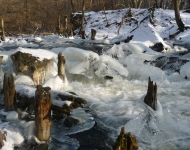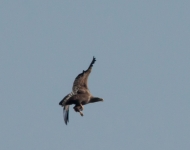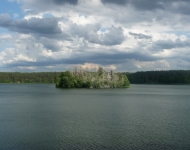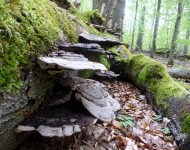Archeology
The first traces of settlements in the Drawa National Park territory and its surroundings reach back to the palaeolith. Comprised forest complexes of the Drawa Wilderness did not favour colonization, therefore only fertile soil enclaves and non-wooded areas were used for building of settlements. More numerous remains of human settlements are known to have originated in the middle stone age, about 6 thousand years ago. The hunting and fishing societies, settling within the Drawa Wilderness area, took advantage of the abundance of fish and game in this richly diversified expanse of forests and lakes. In mesolythic period this area was among to most populated regions of the Central-European lowlands. Traces of human presence, mainly small stone tools, were most commonly found in sandy hills near the water. Among the oldest founds is a palaeolythic hearth of stone construction from Radęcin, and a palaeolithic hut discovered in Jaglisk, at the edge of the DNP surroundings. The earliest peoples arrived in this region from the Danube area, occupied themselves with farming, and represented the so-called band-pottery culture. In farming they used the method of digging with a stone hoe. Another group, who were farmers and cattle-breeders, represented the so-called culture of funnel-goblets. In neolith, a third group appeared, belonging to the so-called culture of string pottery, and occupied themselves primarily with shepherding. Ensuing, this group became a part of the so-called early-bronze culture of the northern Poland. In the early iron age, these areas found themselves within the influence of the Lusatian culture. The inhabitants were not ethnically homogeneous and should not be associated with the pre-Slavic peoples from the Pomerania (Pomorze) region. In the third period of the bronze age there was a cremating cemetery in Drawno, where some lump pottery were discovered, as well as a bronze bracelet and a folded pin. The Roman influence period (from the 3rd to 5th century) was the time of trade contacts with the Roman provinces. The Pomeranian region was at that time inhabited by Germans related to some Baltic tribes.
Within the DNP and its surrounding area, there are archeological monuments existing in their own land forms, and visible on the earth surface. They are: a stronghold on Drawa, north from Drawnik, ruins of a castle in Drawno, a barrow burial ground by the Lake Dominikowo Wielkie, and the so-called Swedish Entrenchments – fortifications from the 30-year war – by the Zawilcowe Lasy reserve.
The DNP area was inhabited by Slavs during the Middle Ages. Then the entire region was entirely dominated by Pomeranian tribes. The Drawno area, along with West Pomerania, were included in the first Polish state established by Mieszko the 1st. However, the Pomeranian dukes were inclined to loosen their connections with Poland, which resulted in numerous battles. In the beginning of the 13th century, the border between the Greater Poland (Wilelkopolska) and Pomerania was moved north, above Choszczno and Drawno, and the whole area was included in Wielkopolska. As the result of quarrels between Polish and Pomeranian dukes at the Brandenburg side, after the death of Przemysław II, some significant changes occurred on this territory – the area all the way north to Gwda was conquered by the Brandenburg margraves. It’s become a part of the New Margraviate. Then the chivalric dynasty of the Welds appeared, and played a significant role for these parts of the land. The Welds, when fighting the Pomeranians, were on the Brandenburg side; later, however, they gave their property to Poland. In the second half of the 14th century, Ziemia Wałecka with Tuczno and Człopa were returned to Poland, and the border between Greater Poland and Brandenburg settled on the line of Drawa and Płociczna rivers, with only small changes,until the 18th century. From the beginning of the 15th century Teutonic Knights ruled this area because the order received the New Margraviate as a lien. That period was very unsettled, and abundant in disagreements and battles between supporters of the Teutonic Order and its opponents. This resulted in selling of the New Margraviate to the Brandenburg Electorate in 1454.
From the Middle Ages until the 19th century colonization of the Drawa Wilderness was in effect, at different degrees of intensity. During that process, many of the existing settlements were being relocated. In the Middle Ages colonization was mainly performed by monastic orders. The first conferments were given to the Johanites, who didn’t play a significant role in the history of the New Magraviate. The Cisterian Order, however, originating from France, marked its presence on this territory in a very essential way. From 1293 the Cysterian Abbey was in existence in Bierzwinik. A monastic order whose duty was to perform agricultural work, has built dams and weirs in this area, dried wet soils, cut woods, cultivated wastelands, and built mills. In the 1530’s the Cisterian properties were liquidated and became part of the state domain.
The relocation of settlements and populating of the deserted villages of Drawa Wilderness took place in the 16th century, a period of relative peace in this area. Rüdiger Wedel from Drawno was continuing his colonizing action. That was when Brzeziny, Dominikowo, Głusko, Ostrowiec, Krępa, Namieńsko, Nowa Korytnica, Nowa Studnica, Miradz, Rościn, Sitno, and Brzeźniak were founded. The next colonizing action was conducted by the Brandenburg state domain in the 17th century. Founded then was Radachowo; Zatom was relocated to the salt trail from Wielkopolska to Kołobrzeg. That colonization also resulted in founding the villages of Łęczyn, Mostniki, Moczele, and in the end of the 18th and the beginning of the 19th centuries farm villages such as Święcichów, Podegrodzie, Borowiec, Dłusko, and Konotop. In the beginning of the 19th century, after previous colonizing actions in the Drawa Wilderness, the process of withdrawing the colonies from the forests gradually began. The lands of the present-day Drawa National Park were under Prussian administration during the entire 19th century. In the years 1815-1918 only the Przesieka area belonged to the superficially autonomous Great Princedom of Poznań. The remaining territory was under the rule of Brandenburg, Pomerania, and the West Prussia. In the years 1922-1938 the described area was part of the so-called Border Margraviate. Just as then, today also the DNP territory is on the borders of three provinces: Zachodniopomarskie, Lubuskie, and Wielkopolskie




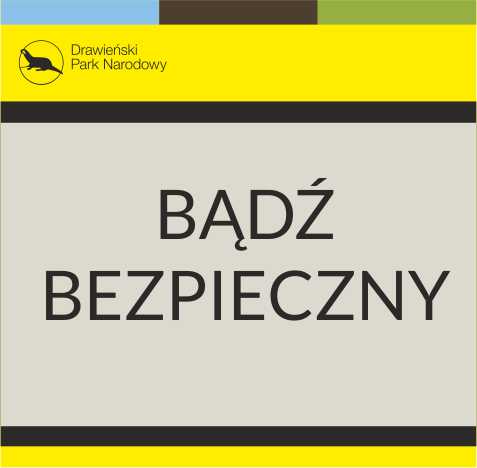

Search
Gallery
Newsletter
Będziemy informować Cię o nowościach w serwisie oraz ważnych wydarzeniach w Parku.
Contact
ul. Leśników 2, 73-220 Drawno,
tel.: (095) 768 20 51,
(095) 768 20 52
fax: (095) 768 25 10
email: [email protected]









